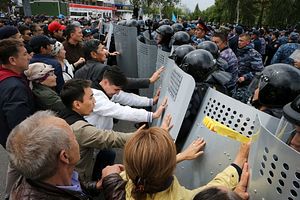Nursultan Nazarbayev reigned over Kazakhstan’s destiny for 30 years. He will be remembered for a form of “enlightened authoritarianism” that made his country quite visible on the international scene, and in particular for his championing of global denuclearization. He will also be celebrated for being among the few leaders to have held power for three decades without either dying in office or leaving power in the face of street protests – compare Nazarbayev’s March 19 resignation with the reluctance showed by Abdelaziz Bouteflika in Algeria and Omar al-Bashir in Sudan at the same time.
But Nazarbayev’s legacy will be darkened not only by a poor track record of democratization and political institutionalization, but also by the mismanagement of the transition since his resignation in March.
Nazarbayev’s decision to leave the presidency of his own volition is quite unique in the post-Soviet space, where presidents tend to be ousted by “color revolutions” (as in Ukraine, Armenia, Georgia, and Kyrgyzstan) or die in power (as in Azerbaijan, Turkmenistan, and Uzbekistan). The trick here is that leaving the presidency does not mean leaving power: Nazarbayev remains the head of the Security Council and of the presidential party, Nur Otan, and also leads the newly created “Office of the First President.” He will continue to cast a long shadow over Kazakhstani politics, a reality reinforced by the strong administrative and financial positions occupied by his family members, especially his oldest daughter, Dariga, who is the incumbent chairwoman of the Senate. Nazarbayev thus managed to pull off a double feat: Winning prestige and respect by leaving the presidency peacefully while securing his position probably for life thanks to his continued functions.
The “denazarbayefication” of Kazakhstan will therefore be a long process that will unfold in at least three steps. Step one was leaving the presidency and announcing snap elections for his dauphin, Kassym-Jomart Tokayev; step two will be reigning in parallel with Tokayev, thereby giving Kazakhstan a diarchy perhaps similar to the “tandemocracy” with which Russia’s Vladimir Putin and Dmitry Medvedev toyed between 2008 and 2012; and step three will come when Nazarbayev someday disappears from the scene and the president in power at that time finally becomes the only one. In this still uncertain trajectory, a fourth step could be envisioned: Tokayev could be elected as president for a few years until Dariga, whose political ambitions have never been a secret, can secure enough stature to get elected herself. In that case, Kazakhstan would become a dynastic republic – like its neighbor Azerbaijan – with an interregnum under Tokayev. Yet to date public opinion has shown no support for the former president’s daughter.
Nazarbayev’s well-choreographed strategy has not unfolded smoothly so far. Although Tokayev was elected with 71 percent of the vote in the June 9 poll, this came against a backdrop of serious protests against the handpicking of Nazarbayev’s successor and accusations of a falsification of the vote.

































